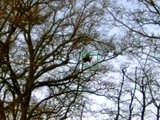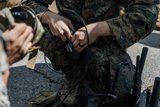Northrop Grumman selected for DARPA AESA programme
Northrop Grumman will conduct work to develop and demonstrate advanced wideband digital antenna technology for next generation radio frequency (RF) sensors using active electronically scanned arrays (AESAs). The company announced on 10 September that it had been selected for an $11.9 million contract for the work by the Defense Advanced Research Projects Agency (DARPA).
The work will be carried out under phase one of the Arrays on Commercial Timescales (ACT) programme. This programme aims to develop the key technologies for affordable, next-generation AESAs by designing a reusable digital common module that contains the critical integrated circuits required for next generation AESAs.
Through common module reuse, high levels of integration and the application of high-volume commercial Complementary Metal Oxide Semiconductor (CMOS) integrated circuit technology, ACT hopes to greatly reduce the development and manufacturing cost of future digital arrays.
William Phillips, director of advanced technology, Northrop Grumman Electronic Systems sector, said: ‘Our wideband digital common module design is a breakthrough in AESA capability, enabled by the application of commercial system-on-chip technology with integrated high speed data converters that enable direct RF sampling. The reusable common module provides the key building block that will make digital AESA technology affordable for a wide variety of applications.’
Northrop Grumman will work with subcontractors Semtech and Systems & Technology Research on the programme.
Craig Hornbuckle, chief systems architect, Semtech, added: ‘Our disruptive ultrahigh speed analogue-to-digital and digital-to-analogue converter technology will help revolutionise phased array technology. With an input bandwidth extending through K-band, these data converters enable increased flexibility and functionality, reduced power, and enhanced performance over traditional architectures, supporting next-generation radar, electronic warfare and satellite communications applications.’
More from Digital Battlespace
-
![Chess Dynamics successfully demonstrates Vision4ce AI-driven tracker]()
Chess Dynamics successfully demonstrates Vision4ce AI-driven tracker
The Vision4ce Deep Embedded Feature Tracking (DEFT) technology software is designed to process video and images by blending traditional computer vision with artificial intelligence (AI) algorithms to present actionable information from complex environments.
-
![Wave Relay devices cleared for security use on commercial systems in industry trend]()
Wave Relay devices cleared for security use on commercial systems in industry trend
Persistent Systems has been cleared by National Security Agency (NSA) to transmit sensitive data on commercial networks. The devices are added to the NSA’s Commercial Solutions for Classified (CSfC) component list which also includes other companies’ products providing the same security.
-
![UK teases cyber spending boost in Strategic Defence Review ahead of “imminent” release]()
UK teases cyber spending boost in Strategic Defence Review ahead of “imminent” release
The release of the UK’s Strategic Defence Review (SDR) has been long promised as mid-year. It is possible it could be as early as 2 June although the UK Ministry of Defence (MoD) continues to play its cards close to its chest.
-
![Intelsat emphasises SATCOM resilience for SOF in contested domains (video)]()
Intelsat emphasises SATCOM resilience for SOF in contested domains (video)
Intelsat outlines how its multi-orbit SATCOM architecture is enhancing connectivity and resilience for special operations forces operating in degraded and contested environments.
-
![US Space Force’s next-generation missile warning system moves forward with $500 million in new contracts]()
US Space Force’s next-generation missile warning system moves forward with $500 million in new contracts
Next-Generation Overhead Persistent Infrared (Next-Gen OPIR) satellites are intended to provide early warning of missile launches from any location worldwide and new ground stations will result in expanded coverage of critical missile warning.
























